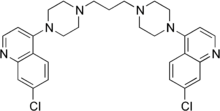Piperaquine
 | |
|---|---|
| Systematic (IUPAC) name | |
| 1,3-bis[4-(7-chloroquinolin-4-yl)piperazin-1-yl]propane | |
| Clinical data | |
| Legal status | ? |
| Identifiers | |
| CAS number | 4085-31-8 |
| ATC code | ? |
| PubChem | CID 122262 |
| UNII | A0HV2Q956Y |
| ChEMBL | CHEMBL303933 |
| Chemical data | |
| Formula | C29H32Cl2N6 |
| Mol. mass | 535.51 |
| SMILES
| |
| | |
Piperaquine is an antimalarial drug, a bisquinoline first synthesised in the 1960s, and used extensively in China and Indochina as prophylaxis and treatment during the next 20 years. Usage declined in the 1980s as piperaquine-resistant strains of P. falciparum arose and artemisinin-based antimalarials became available. However, Chinese scientists have been studying whether piperaquine can still be used therapeutically in combination with artemisinin.[1]
Piperaquine is characterized by slow absorption and a long biological half-life,[2] making it a good partner drug with artemisinin derivatives which are fast acting but have a short biological half-life.[3]
The fixed-dose combination dihydroartemisinin-piperaquine (Eurartesim) was submitted for approval to the European Medicines Agency in 2009.[4]
References
- ↑ Davis TM, Hung TY, Sim IK, Karunajeewa HA, Ilett KF (2005). "Piperaquine: a resurgent antimalarial drug". Drugs 65 (1): 75–87. PMID 15610051.
- ↑ D'alessandro U. (2009). "Progress in the development of piperaquine combinations for the treatment of malaria". Curr Opin Infect Dis 22 (6): 588–92. doi:10.1097/QCO.0b013e328332674a. PMID 19773652.
- ↑ http://apps.who.int/prequal/info_applicants/Guidelines/Nonclinical_Overview_Artemisinin-Derivatives.pdf"
- ↑ Medicines for Malaria. "Registration". Retrieved 2010-06-20.